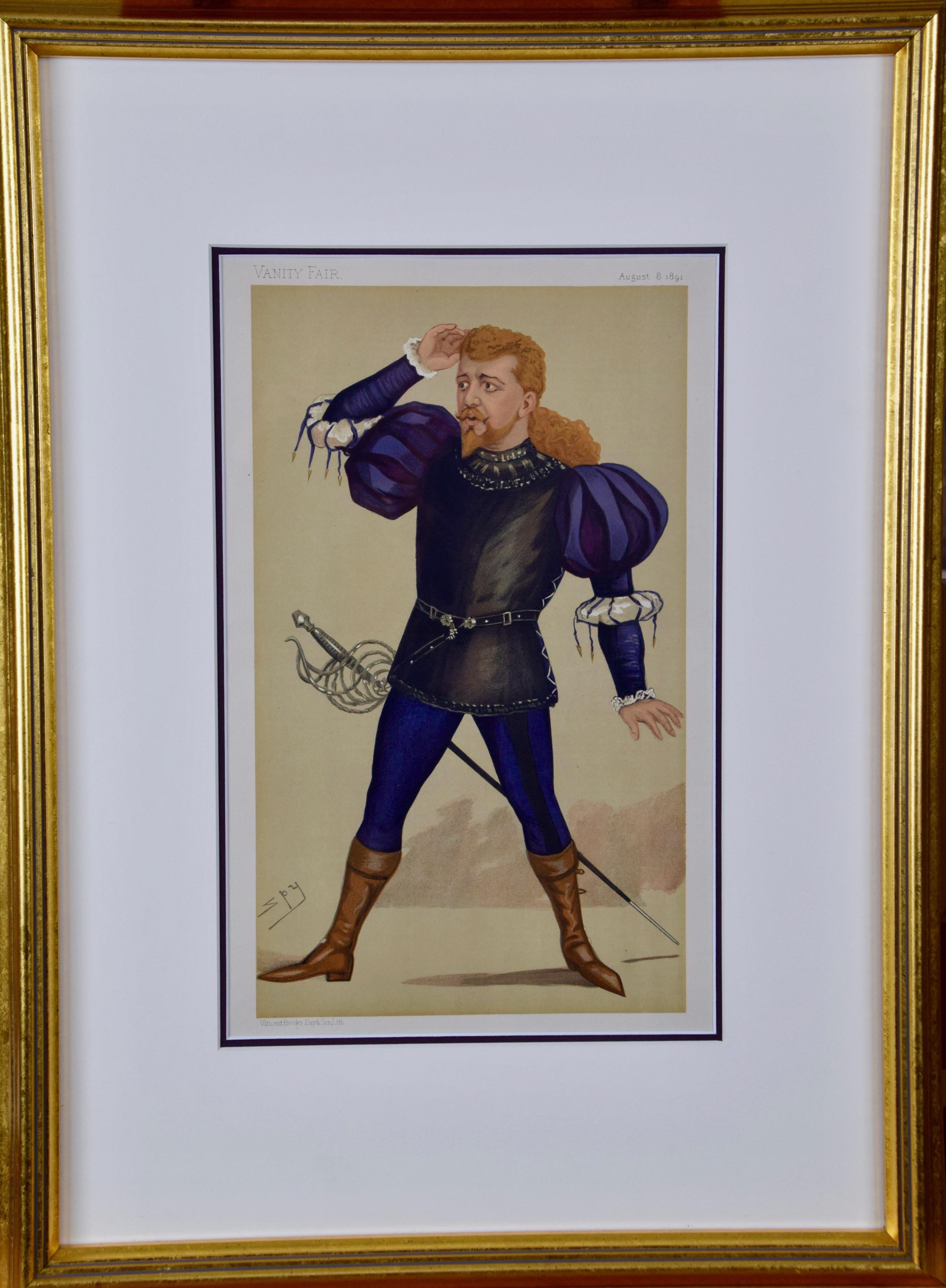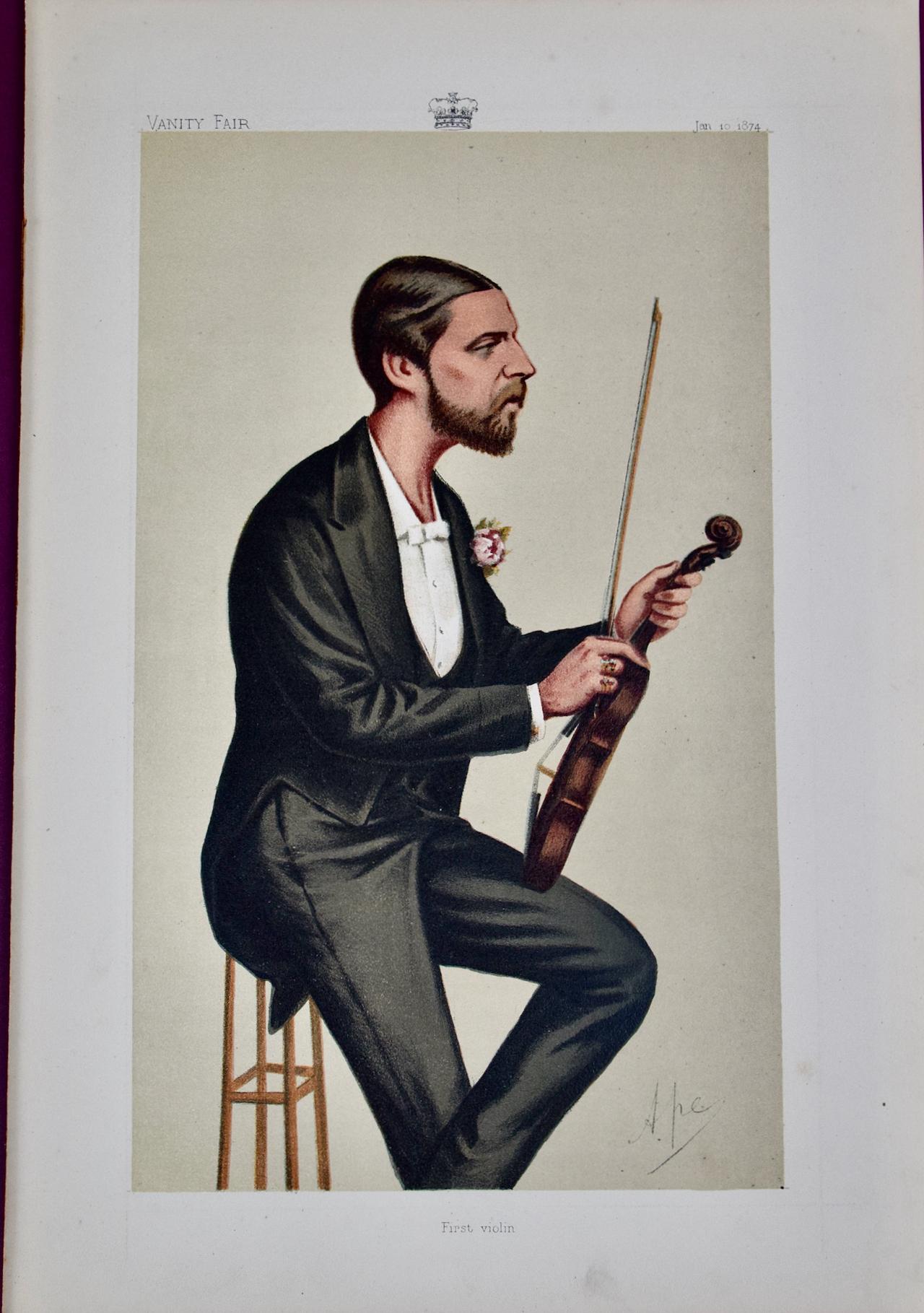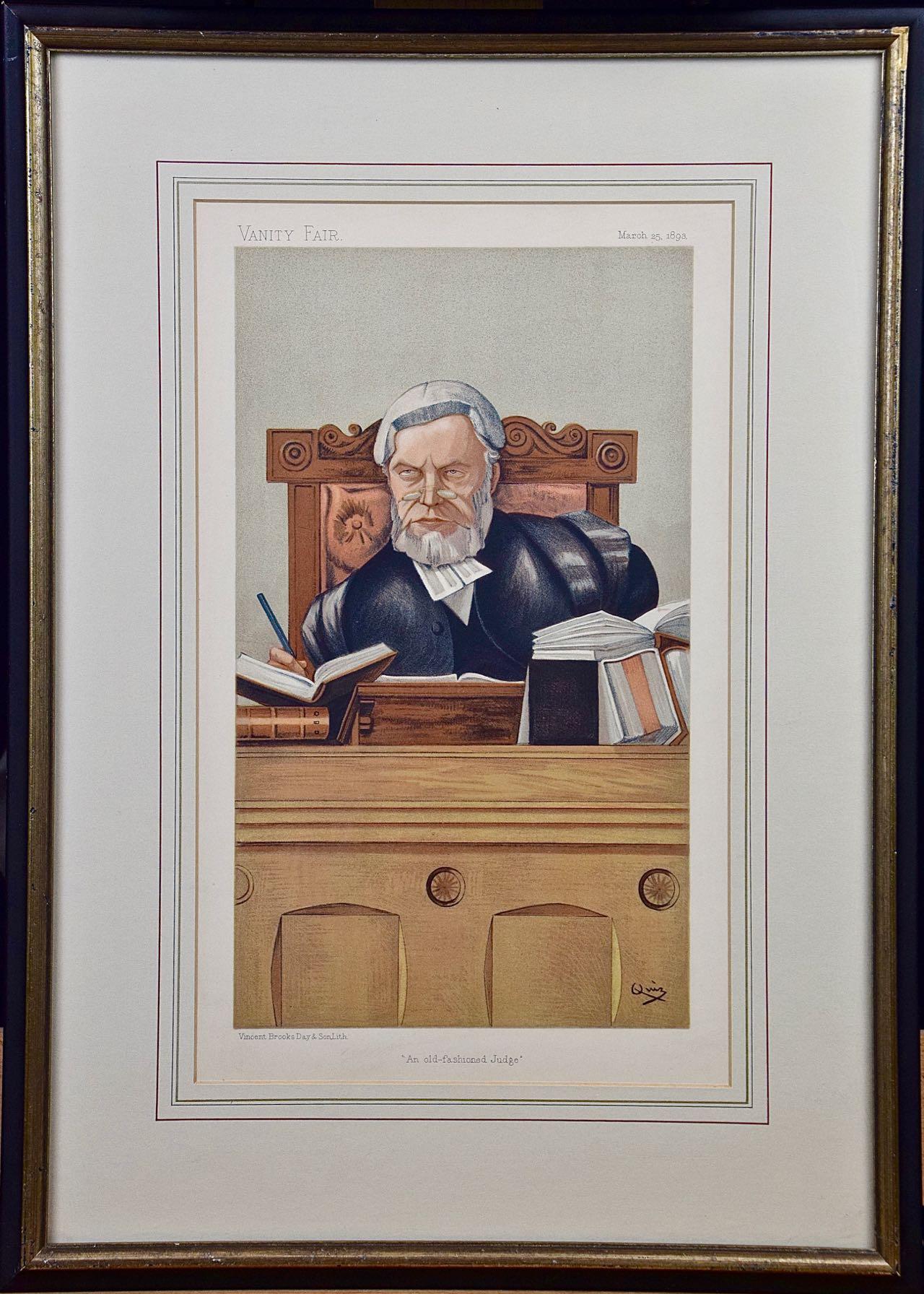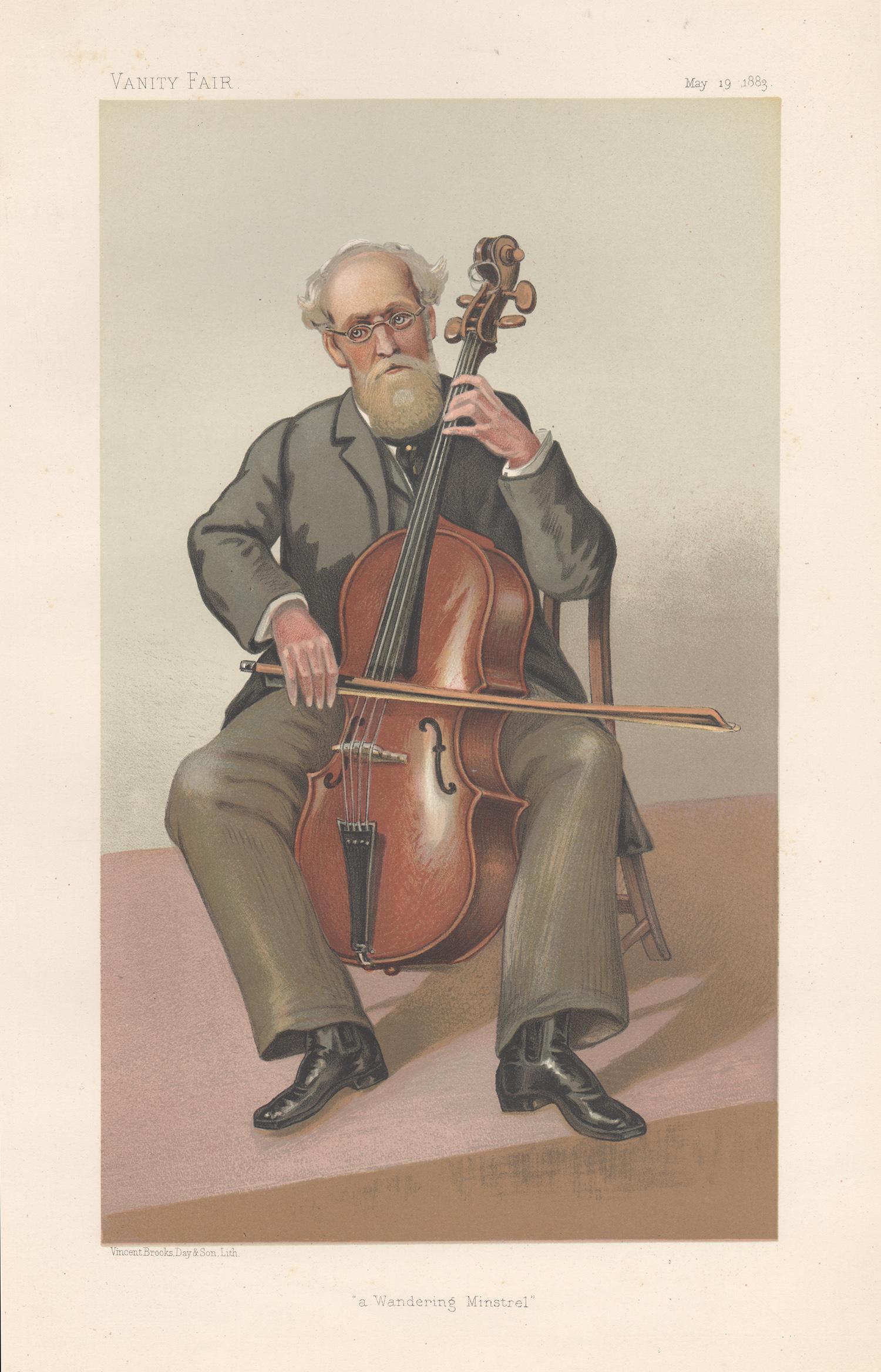Items Similar to Sir Henry James, Statesman: 19th C. Vanity Fair Caricature by Pellegrini (Ape)
Want more images or videos?
Request additional images or videos from the seller
1 of 10
Carlo Pellegrini 1Sir Henry James, Statesman: 19th C. Vanity Fair Caricature by Pellegrini (Ape)1874
1874
About the Item
A Vanity Fair chromolithograph caricature of Sir Henry James, M.P., ("Nervous"), Statesman by Ape (Carlo Pellegrini) March 7, 1874, No. 164 from the "Statesman" series. James had a law practice and was a judge, before winning a seat in parliament and became England's Attorney General.
There are occasional faint spots, but the lithograph is otherwise in very good condition. The original text page from the Vanity Fair publication describing the subject of the caricature portrait is included..
From 1868 until February 5, 1914, Vanity Fair, a weekly magazine of social, literary and political content, was very popular in Victorian and later, Edwardian England. The most popular of its features were the full page caricatures of famous men and women of the day which included their biographies, which remains the magazines lasting legacy. Vanity Fair's most famous artists were Carlo Pellegrini who signed his works “Ape” and Leslie Ward, known as “Spy”, but many other artists and writers contributed caricatures and prose to the publication, including Lewis Carroll, Willie Wilde, P. G. Wodehouse, Jessie Pope and Bertram Fletcher Robinson.
Thomas Gibson Bowles was the founder, owner, and editor of the magazine until 1889. He described the images as "grim faces made more grim, grotesque figures made more grotesque, and dull people made duller by the genius of our talented collaborator 'Ape'; but there is nothing that has been treated with a set purpose to make it something that it was not already originally in a lesser degree."
Carlo Pellegrini, contributed to the success of Vanity Fair in the early years. He was born and trained in Italy, but moved to London in 1864, at age 25. He was eccentric and soon became popular in British society. Pellegrini has been referred to as “the presiding artistic genius of Vanity Fair’s early years”. He signed his work with the pseudonym “Ape”, a reference to the ape-like features that he frequently used to characterize his subjects.
- Creator:Carlo Pellegrini 1 (1839 - 1889, Italian)
- Creation Year:1874
- Dimensions:Height: 15 in (38.1 cm)Width: 10.25 in (26.04 cm)
- Medium:
- Movement & Style:
- Period:
- Condition:
- Gallery Location:Alamo, CA
- Reference Number:
About the Seller
5.0
Vetted Seller
These experienced sellers undergo a comprehensive evaluation by our team of in-house experts.
Established in 2011
1stDibs seller since 2019
233 sales on 1stDibs
Typical response time: 1 hour
- ShippingRetrieving quote...Ships From: Alamo, CA
- Return PolicyA return for this item may be initiated within 7 days of delivery.
More From This SellerView All
- William Booth, Founder of "The Salvation Army": A 19th C. Vanity Fair CaricatureBy Sir Leslie WardLocated in Alamo, CAThis is a 19th century Vanity Fair color chromolithograph caricature of William Booth "The Salvation Army" by Spy (Leslie Ward) November 25, 1882, No. 2...Category
Late 19th Century Victorian Portrait Prints
MaterialsLithograph
- Vanity Fair Caricature, Rev. Edgar Sheppard "A Great Marrier" by SpyBy Sir Leslie WardLocated in Alamo, CAVanity Fair color chromolithograph caricature of Rev. Edgar Sheppard "A Great Marrier" by Spy (Leslie Ward) March 14, 1904 from the "Clergymen" series....Category
Late 19th Century Victorian Portrait Prints
MaterialsLithograph
- Hand Colored 19th c. Vanity Fair Caricature of an Opera Singer, "Polish Tenor"By Sir Leslie WardLocated in Alamo, CAA hand colored Vanity Fair caricature of a 19th century opera singer, M Jean de Reszke, entitled 'Polish Tenor'. The print was created by the most famou...Category
1890s Victorian Portrait Prints
MaterialsLithograph
- 1st Violin Duke of Edinburgh: 19th C. Vanity Fair Caricature by Ape (Pellegrini)By Carlo Pellegrini 1Located in Alamo, CAVanity Fair color chromolithograph caricature of "First Violin " Prince Alfred, Duke of Edinburgh and Saxe-Coburg and Gothan by Ape (Carlo Pellegrini)...Category
Late 19th Century Victorian Portrait Prints
MaterialsLithograph
- Original 19th C. Vanity Fair Caricature of "An Old Fashioned Judge", Henry LopesBy Sir Leslie WardLocated in Alamo, CAA framed hand-colored Vanity Fair caricature of a prominent 19th century English judge, Henry Charles Lopes, 1st Baron Ludlow (1828-1899) entitled "An O...Category
1890s Victorian Portrait Prints
MaterialsLithograph
- Qua-Ta-Wa-Pea, A Shawnee: 19th C. Folio Hand-colored McKenney & Hall LithographBy McKenney & HallLocated in Alamo, CAThis is an original 19th century hand-colored folio-sized lithographic portrait of a Native American entitled "Qua-Ta-Wa-Pea, A Shawanoe Chief", from McKenney and Hall's 'History of the Indian Tribes of North America'. It was lithographed by J. T. Bowen after a painting by Charles Bird King and published by E. C. Biddle in Philadelphia in 1836. Quatawapea wears a maroon head covering, a white ruffled shirt and blue shawl with gray trim. His presidential peace medal is attached to a maroon fabric...Category
Mid-19th Century Naturalistic Portrait Prints
MaterialsLithograph
You May Also Like
- Lord Gerald Fitzgerald, Vanity Fair music cello portrait chromolithograph, 1883By Sir Leslie WardLocated in Melbourne, Victoria'a Wandering Minstrel'. Vanity Fair portrait of Lord Gerald Fitzgerald who was principal cello of the Wandering Minstrels who were an orchestra of aristocrats who gave the first ev...Category
Late 19th Century Victorian Portrait Prints
MaterialsLithograph
- George Barrett, jockey, Vanity Fair horse racing portrait chromolithograph, 1887By Sir Leslie WardLocated in Melbourne, Victoria'George Barrett' Vanity Fair portrait of George Barrett (1863-1898) who was a leading English jockey. His won the 1885 1000 Guineas aboard Farewell an...Category
Early 20th Century Victorian Portrait Prints
MaterialsLithograph
- Henry Searle, rower, Vanity Fair rowing portrait chromolithograph, 1889By Sir Leslie WardLocated in Melbourne, Victoria'H Searle, Professional Champion Sculler of the World'. Vanity Fair rowing portrait of Henry Searle (1866-1889), an Australian sculler who raced in 1889 the American champion Willia...Category
Late 19th Century Victorian Portrait Prints
MaterialsLithograph
- Frank Wootton, jockey, Vanity Fair horse racing portrait chromolithograph, 1909By Sir Leslie WardLocated in Melbourne, Victoria'Frank Wootton' Hentschel-Colourtype, 1909 Vanity Fair portrait of Frank Wootton. (1893 -1940), known as "Frank" or "Frankie", and sometimes referred to as "The Wonderboy", who wa...Category
Early 20th Century Victorian Portrait Prints
MaterialsLithograph
- Leonard Braund, Empire Cricketeer, English cricket portrait lithograph, 1905By Albert Chevallier TaylerLocated in Melbourne, VictoriaLeonard Braund was a bowler for Somerset and England. Tayler was an English artist who was a member of the Royal Academy of Painters. He was a cricketer himself, and in 1905 he made...Category
Early 20th Century Victorian Portrait Prints
MaterialsLithograph
- Walter Lees, Empire Cricketeer, English cricket portrait lithograph, 1905By Albert Chevallier TaylerLocated in Melbourne, VictoriaWalter Lees was a bowler for Surrey and England. Tayler was an English artist who was a member of the Royal Academy of Painters. He was a cricketer himsel...Category
Early 20th Century Victorian Portrait Prints
MaterialsLithograph
Recently Viewed
View AllMore Ways To Browse
Late Edwardian
Vanity With Seat
Victorian Fairings
Antique Fairs England
Antique Fairs London
Set Victorian Prints
Antique Vanity Other
Antique Vanity Sets
Vanity Set Antique
Antique Vanity Set
Henry M Print
19th Century Portraits Of Men
Antique Vanity Seat
British Judge
G Robinson
19th Century Robinson
British Caricature
Antique Gibson





